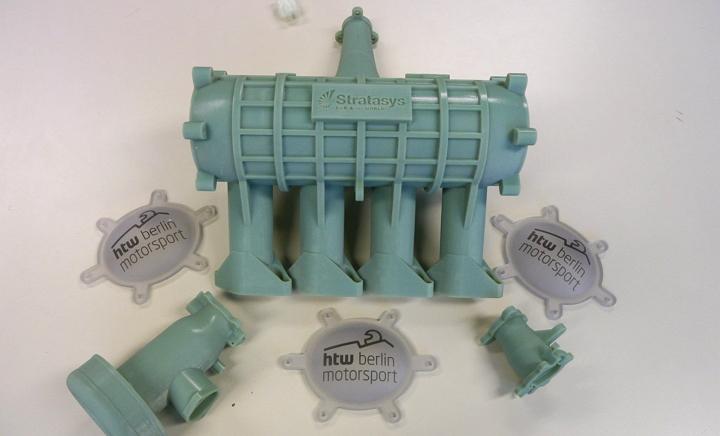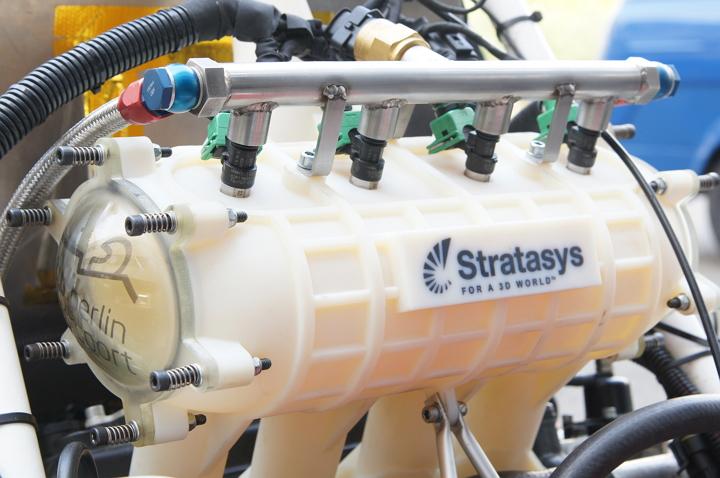The margins in motor sports racing are razor thin. An extra tenth of a second a lap can be the difference between being a winner and finishing back in the pack.
 That’s why HTW Motortsport turned to Stratasys to help them find a 10% increase in horsepower with 3D printed parts which outperform parts made via traditional manufacturing methods.
That’s why HTW Motortsport turned to Stratasys to help them find a 10% increase in horsepower with 3D printed parts which outperform parts made via traditional manufacturing methods.
HTW Motorsport says they’ve found cost and workflow efficiencies all while increasing their on-track performance of their Formula-type race car as a result of Stratasys 3D printing technology.
The HTW car participated in the global Formula SAE competition in which teams design, build, test, and race small-scale, Formula-style cars which are then judged on their design, fuel economy, acceleration, and endurance capabilities. The race vehicle in question was the result of a student project at the University of Applied Sciences in Berlin, Germany.
Patrick Harder, a team engineer at HTW Motorsport, says 3D printing complex parts is the preferred method of manufacturing the race-ready airboxes used in the Formula SAE entry, the BRC14.
“As a university project, having access to Stratasys’ advanced 3D printing technology offers us a massive boost. It enables us to develop the required parts much faster and incredibly more cost-effectively than we would otherwise be able to,” Harder says. “This has delivered proven, quantifiable benefits on the BRC14’s airbox system, with a comparative increase in horsepower of around 10% versus the system we used two years before. We also enjoyed an increase in torque of almost 12% over the same time frame.”
The airbox system was built with a Stratasys Objet500 Connex multi-material 3D Production System from high-performance, photopolymer Digital ABS material.
“A well-designed airbox will draw air more efficiently and effectively into the engine, and thus improve performance,” Harder says. “The role of 3D printing is fundamental as it allows us to create a functional prototype which then becomes part of the final race vehicle.”
Stratasys Digital ABS was the material of choice as it meets the various requirements for the airbox design and performance.
“High temperature resistance and fuel resistance are vital prerequisites for the airbox, so Digital ABS is perfect,” Harder says. “Its high strength-to-weight ratio makes it the best material for the airbox’s plenum chamber which requires a combination of toughness, unique geometry and high surface finish.”

HTW Motorsport Stratasys Airbox
Harder says HTW Motorsport is in the design process right now to build their next, and he says it should be ready to roll out in June in preparation for this year’s race season.
“With the help of Stratasys 3D printed parts, we are aiming to reduce the weight of our next car by around 45Kg,” says Harder. “This will see us incorporate a fully-3D printed steering wheel and fuel tank, as well as a slightly smaller 3D printed airbox. We’ll also be constructing a number of boxes that house the many micro-controllers on the car and expect 3D printing to deliver almost 80% weight reduction compared to using standard options from electronic suppliers.”
The design competition was organized by the Society of Automotive Engineers and established as Formula SAE in the US. The Formula Student is held in Germany, and HTW Motorsport has taken part in the competition since its inception in 2006. A jury of experts from the automotive industry uses the competition to find future engineers and assess the initiative and commitment of the students involved.
Do you know of any other motorsports applications of 3D printing? Let us know in the HTW Motorsport 3D Printed Airbox forum thread on 3DPB.com. Check out the video below of the ‘track test’ for HTW Motorsport’s airbox.
Subscribe to Our Email Newsletter
Stay up-to-date on all the latest news from the 3D printing industry and receive information and offers from third party vendors.
You May Also Like
3D Printing Unpeeled: Biofuel Waste to Filament & Sustainable Photopolymers
I can’t ever remember a day with so many potentially high impact news stories have come out. In one story, we all know that there are problems with the safety...
Finnair Hires AM Craft to 3D Print Plastic Parts for Aircraft Interiors
Riga-based AM Craft, a supplier specialized in 3D printing aviation components and certified under EASA Part 21G, announced a significant achievement today. The company will assist in upgrading Finnair’s A320...
3DPOD Episode 198: High Speed Sintering with Neil Hopkinson, VP of AM at Stratasys
Neil Hopkinson, a pioneering 3D printing researcher, played a pivotal role in developing a body of research that is widely utilized today. He also invented High Speed Sintering (HSS), also...
3D Printing Webinar and Event Roundup: May 12, 2024
Webinars and events are picking up in the AM industry this week! ASTM International continues its Professional Certificate Course and Stratasys continues its advanced in-person trainings, while 3D Systems is...

































